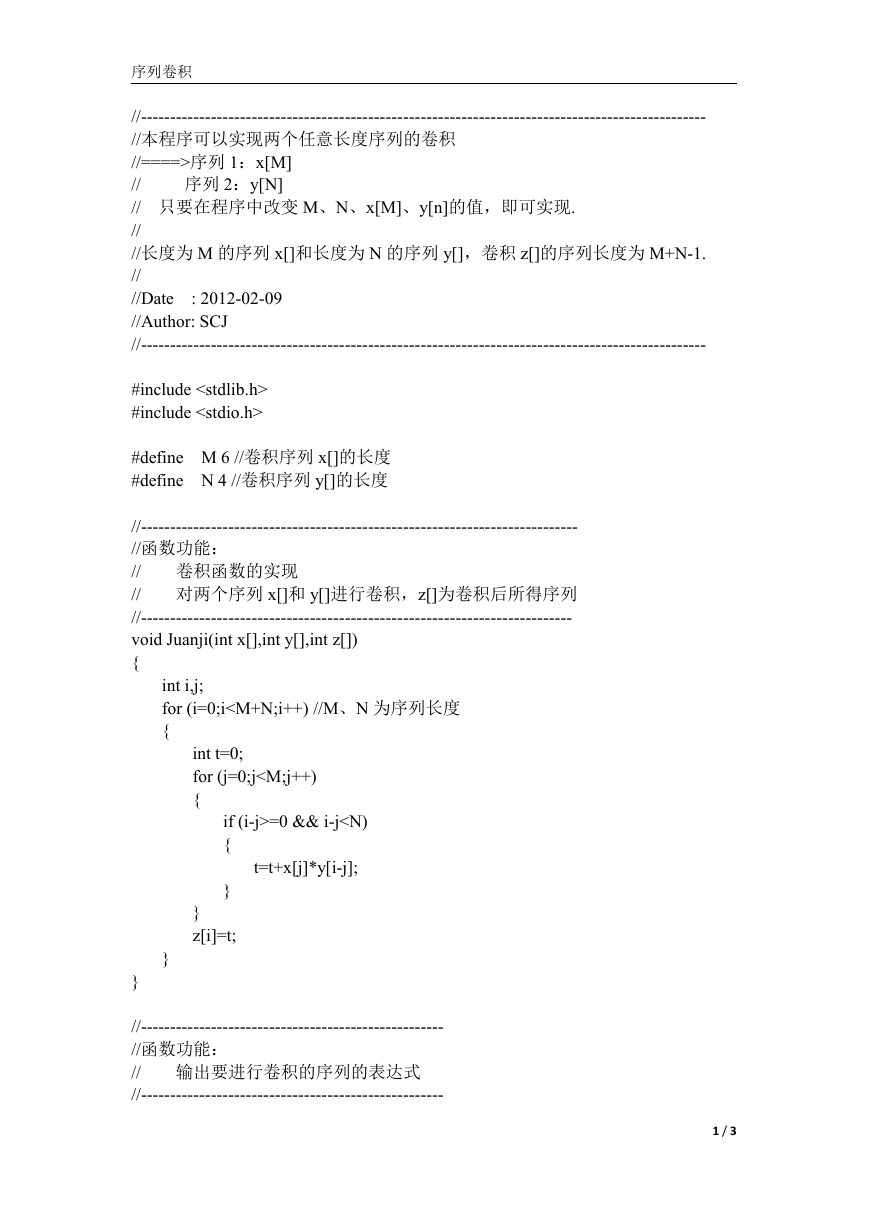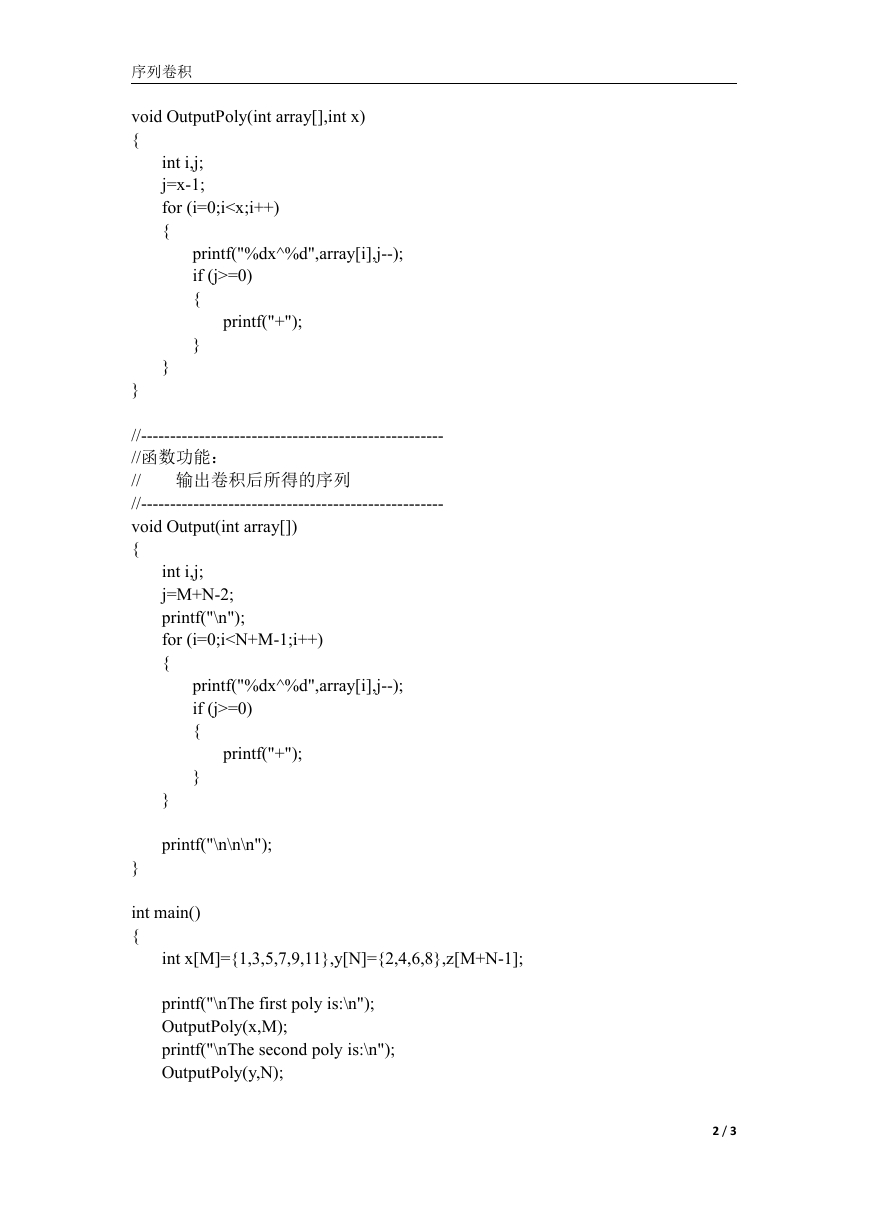序列卷积
//-------------------------------------------------------------------------------------------------
//本程序可以实现两个任意长度序列的卷积
//====>序列 1:x[M]
//
序列 2:y[N]
// 只要在程序中改变 M、N、x[M]、y[n]的值,即可实现.
//
//长度为 M 的序列 x[]和长度为 N 的序列 y[],卷积 z[]的序列长度为 M+N-1.
//
//Date
//Author: SCJ
//-------------------------------------------------------------------------------------------------
: 2012-02-09
#include
#include
#define M 6 //卷积序列 x[]的长度
#define N 4 //卷积序列 y[]的长度
//---------------------------------------------------------------------------
//函数功能:
// 卷积函数的实现
// 对两个序列 x[]和 y[]进行卷积,z[]为卷积后所得序列
//--------------------------------------------------------------------------
void Juanji(int x[],int y[],int z[])
{
int i,j;
for (i=0;i=0 && i-j序列卷积
void OutputPoly(int array[],int x)
{
int i,j;
j=x-1;
for (i=0;i=0)
{
printf("+");
}
}
}
//----------------------------------------------------
//函数功能:
// 输出卷积后所得的序列
//----------------------------------------------------
void Output(int array[])
{
int i,j;
j=M+N-2;
printf("\n");
for (i=0;i=0)
{
printf("+");
}
}
printf("\n\n\n");
}
int main()
{
int x[M]={1,3,5,7,9,11},y[N]={2,4,6,8},z[M+N-1];
printf("\nThe first poly is:\n");
OutputPoly(x,M);
printf("\nThe second poly is:\n");
OutputPoly(y,N);
2 / 3
�
序列卷积
Juanji(x,y,z);
printf("\n\nThe result poly is:\n");
Output(z);
return 0;
}
3 / 3
�






 2023年江西萍乡中考道德与法治真题及答案.doc
2023年江西萍乡中考道德与法治真题及答案.doc 2012年重庆南川中考生物真题及答案.doc
2012年重庆南川中考生物真题及答案.doc 2013年江西师范大学地理学综合及文艺理论基础考研真题.doc
2013年江西师范大学地理学综合及文艺理论基础考研真题.doc 2020年四川甘孜小升初语文真题及答案I卷.doc
2020年四川甘孜小升初语文真题及答案I卷.doc 2020年注册岩土工程师专业基础考试真题及答案.doc
2020年注册岩土工程师专业基础考试真题及答案.doc 2023-2024学年福建省厦门市九年级上学期数学月考试题及答案.doc
2023-2024学年福建省厦门市九年级上学期数学月考试题及答案.doc 2021-2022学年辽宁省沈阳市大东区九年级上学期语文期末试题及答案.doc
2021-2022学年辽宁省沈阳市大东区九年级上学期语文期末试题及答案.doc 2022-2023学年北京东城区初三第一学期物理期末试卷及答案.doc
2022-2023学年北京东城区初三第一学期物理期末试卷及答案.doc 2018上半年江西教师资格初中地理学科知识与教学能力真题及答案.doc
2018上半年江西教师资格初中地理学科知识与教学能力真题及答案.doc 2012年河北国家公务员申论考试真题及答案-省级.doc
2012年河北国家公务员申论考试真题及答案-省级.doc 2020-2021学年江苏省扬州市江都区邵樊片九年级上学期数学第一次质量检测试题及答案.doc
2020-2021学年江苏省扬州市江都区邵樊片九年级上学期数学第一次质量检测试题及答案.doc 2022下半年黑龙江教师资格证中学综合素质真题及答案.doc
2022下半年黑龙江教师资格证中学综合素质真题及答案.doc